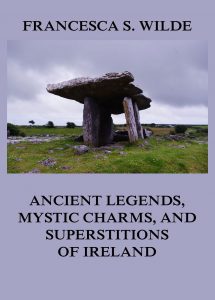Ancient Legends, Mystic Charms, and Superstitions of Ireland – Francesca S. Wilde
Many of the Irish legends, superstitions, and ancient charms now collected were obtained chiefly from oral communications made by the peasantry themselves, either in Irish or in the Irish-English which preserves so much of the expressive idiom of the antique tongue. These narrations were taken down by competent persons skilled in both languages, and as far as possible in the very words of the narrator; so that much of the primitive simplicity of the style has been retained, while the legends have a peculiar and special value as coming direct from the national heart.
Format: Paperback.
Ancient Legends, Mystic Charms, and Superstitions of Ireland.
ISBN: 9783849673604.
Available at amazon.com and other venues.
Early history of Ireland (from wikipedia.com)
The earliest written records of Ireland come from classical Greco-Roman geographers. Ptolemy in his Almagest refers to Ireland as Mikra Brettania (Little Britain), in contrast to the larger island, which he called Megale Brettania (Great Britain). In his later work, Geography, Ptolemy refers to Ireland as Iouernia and to Great Britain as Albion. These “new” names were likely to have been the local names for the islands at the time. The earlier names, in contrast, were likely to have been coined before direct contact with local peoples was made.
The Romans would later refer to Ireland by this name too in its Latinised form, Hibernia, or Scotia. Ptolemy records sixteen nations inhabiting every part of Ireland in 100 CE. The relationship between the Roman Empire and the kingdoms of ancient Ireland is unclear. However, a number of finds of Roman coins have been made, for example at the Iron Age settlement of Freestone Hill near Gowran and Newgrange.
Ireland continued as a patchwork of rival kingdoms but, beginning in the 7th century, a concept of national kingship gradually became articulated through the concept of a High King of Ireland. Medieval Irish literature portrays an almost unbroken sequence of High Kings stretching back thousands of years but modern historians believe the scheme was constructed in the 8th century to justify the status of powerful political groupings by projecting the origins of their rule into the remote past.
All of the Irish kingdoms had their own kings but were nominally subject to the High King. The High King was drawn from the ranks of the provincial kings and ruled also the royal kingdom of Meath, with a ceremonial capital at the Hill of Tara. The concept didn’t become a political reality until the Viking Age and even then was not a consistent one. Ireland did have a culturally unifying rule of law: the early written judicial system, the Brehon Laws, administered by a professional class of jurists known as the brehons.
The Chronicle of Ireland records that in 431, Bishop Palladius arrived in Ireland on a mission from Pope Celestine I to minister to the Irish “already believing in Christ”. The same chronicle records that Saint Patrick, Ireland’s best known patron saint, arrived the following year. There is continued debate over the missions of Palladius and Patrick, but the consensus is that they both took place and that the older druid tradition collapsed in the face of the new religion. Irish Christian scholars excelled in the study of Latin and Greek learning and Christian theology. In the monastic culture that followed the Christianisation of Ireland, Latin and Greek learning was preserved in Ireland during the Early Middle Ages in contrast to elsewhere in Europe, where the Dark Ages followed the Fall of the Western Roman Empire.
The arts of manuscript illumination, metalworking and sculpture flourished and produced treasures such as the Book of Kells, ornate jewellery and the many carved stone crosses that still dot the island today. A mission founded in 563 on Iona by the Irish monk Saint Columba began a tradition of Irish missionary work that spread Celtic Christianity and learning to Scotland, England and the Frankish Empire on Continental Europe after the fall of Rome. These missions continued until the late Middle Ages, establishing monasteries and centres of learning, producing scholars such as Sedulius Scottus and Johannes Eriugena and exerting much influence in Europe.
From the 9th century, waves of Viking raiders plundered Irish monasteries and towns. These raids added to a pattern of raiding and endemic warfare that was already deep-seated in Ireland. The Vikings also were involved in establishing most of the major coastal settlements in Ireland: Dublin, Limerick, Cork, Wexford, Waterford, as well as other smaller settlements.
(The text of the last section was taken from a Wikipedia entry and is available under the the Creative Commons Attribution-ShareAlike License.)
Publisher’s Note: This book is printed and distributed by Createspace a DBA of On-Demand Publishing LLC and is typically not available anywhere else than in stores owned and operated by Amazon or Createspace.

